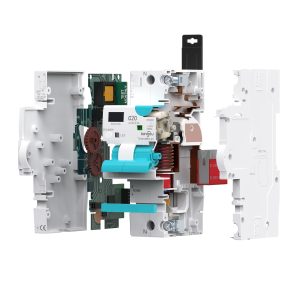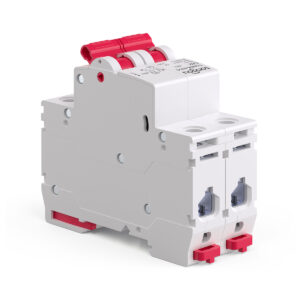
EXHIBITION 2025| TONGOU In China 138th Canton Fair
Booth: Hall 15.2 Booth25-26 Date: October 15-19, 2025

Already know what an RCBO is? Great. This page skips the basics and focuses on nocturnal nuisance trips—why they happen and how to stop them safely.
Moisture/condensation rises overnight → leakage to earth.
Standby electronics (chargers, IT gear) cycle → brief leakage spikes.
Defrost cycles on fridges/heat pumps → inrush + leakage.
Outdoor junctions wick damp through the evening.
RCD type mismatch (A/F/B/EV) with VFD/inverter loads → unwanted trips.
SPD events (switching or storms) stress leakage thresholds.
Shared neutrals or wiring errors → false imbalance.

Bathrooms, gardens, garages, façade lighting.
Symptoms: trips after rain or in humid nights; fixtures feel damp; discolored terminals.
Phone/laptop chargers, routers, AV gear.
Symptoms: sporadic trips when devices auto-cycle or charge timers kick in.
Additional heater elements and switching transients.
Symptoms: trips roughly when defrost programs run.
Wicking through glands; cracked covers; missing gaskets.
Symptoms: more trips after evening sprinklers or dew.
Smooth DC or high-frequency leakage not suited to the installed RCBO type.
Symptoms: trips only when drive/charger idle or during ramp.
Poor earthing or long SPD leads raising local potential.
Symptoms: trips during storms or when large loads switch.
Neutral borrowed from another circuit; mixed rings.
Symptoms: inexplicable, circuit-agnostic trips.
Label the exact branch. List all loads connected (indoor/outdoor).
Note weather, humidity, and switching schedules (defrost, timers).
Open enclosures with power off. Look for dew, corrosion, cracked gaskets, loose glands.
Re-terminate discolored conductors; replace compromised IP fittings.
Unplug chargers/IT gear and non-essential devices on that branch for one night.
Next night, reintroduce one group at a time (e.g., refrigeration only; outdoor lights only).
Use a differential clamp meter around phase+neutral to read residual current.
Compare to RCBO rating (e.g., 30 mA). A baseline >10 mA idle is suspicious.
Type A: pulsed DC (most SMPS).
Type F: mixed frequencies/VFDs (washing machines, heat pumps).
Type B/EV: smooth DC (EV chargers, some PV/VFD).
If mismatch exists, upgrade to the correct type.
Keep SPD lead lengths short; verify solid bonding/earthing.
Poor earthing elevates potentials and can trigger RCDs under transient stress.
Ensure no shared neutrals across different RCBOs.
Map circuits properly; fix any cross-feeds.
| Scenario | Typical Fixes |
|---|---|
| Bathroom/garden circuits trip in humid weather | Replace or reseal fittings; use correct IP-rated enclosures and glands; add drip loops; separate outdoor loads to their own RCBO. |
| Random trips with many chargers/IT gear | Move chargers/AV to a separate RCBO; avoid cheap multi-way adapters; consider Type F if VFD-like loads exist. |
| Fridge/heat-pump trips overnight | Give appliances dedicated RCBOs; check defrost cycles; consider Type F for mixed-frequency leakage. |
| EV/drive/inverter involved | Verify Type B/EV suitability; check charger settings and bonding; follow manufacturer guidance. |
| Trips during storms or big switching | Improve SPD earthing and lead length; ensure coordination with upstream devices. |
| Persistent unexplained trips | Inspect for shared neutrals; perform insulation resistance tests; review terminations for heat and corrosion. |
Trip occurs ~1–2 a.m. on humid nights.
Inspection: cracked gland; condensation inside junction.
Fix: replace fitting, add drip loop, re-terminate; no further trips.
Trip time correlates with backup window.
Baseline leakage ~12–15 mA idle; spikes during PSU ramp.
Fix: move IT gear to a dedicated RCBO; swap to higher-quality PSUs; problem resolved.
Trips only during defrost; VFD-type compressor.
Installed RCBO Type A.
Fix: upgrade to Type F RCBO; verify bonding and SPD. Stable afterwards.
Q1. Why do trips mostly happen at night?
Humidity rises; loads like refrigeration/IT gear change modes; transients from SPDs and switching accumulate.
Q2. Will a higher-rated RCBO stop nuisance trips?
Not safely. Address leakage sources, circuit separation, and RCD type matching first.
Q3. Do I need Type B/EV for all inverters?
Only if the load can generate smooth DC components beyond Type A/F detection. Check manufacturer guidance.
Q4. How much leakage is “normal”?
Small SMPS often contribute 0.5–2 mA each. Multiple devices can push a 30 mA RCBO close to its threshold—hence circuit separation helps.

Johnson Lim is the General Manager of Changyou Technology and has over 10 years of experience in circuit protection technology and residential electrical safety. He is committed to developing and producing safer and smarter electrical products.

Booth: Hall 15.2 Booth25-26 Date: October 15-19, 2025

RCBO Trips at Night? Causes, Diagnosis, and Lasting Fixes Already know what an RCBO is? Great. This page skips the basics and focuses on nocturnal

MCB B/C/D Curves in Practice: How Inrush Current Shapes Your Choice This guide assumes you already know what an MCB is. If you need a

SPD Coordination for Solar PV and EV Charging: Where to Place Type 1/2/3 Already know the difference between Type 1/2/3 and AC vs DC SPDs?

tongou was established in 1993 and is the trademark of Changyou Technology. We position ourselves as providers of intelligent product solutions for high and low voltage electrical systems, taking on solving customers’ pressures and challenges as our responsibility and creating value for them. We utilize intelligent products to serve global customers, making life smarter and more convenient to benefit your life.
Paidong Industrial Zone Qiligang,Yueqing City,Zhejiang province,China.
Sales: [email protected]
After-sales: [email protected]
© 2025 Changyou Technology. All Rights Reserved.

